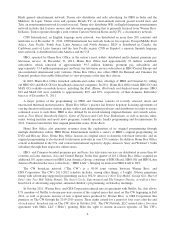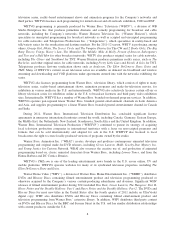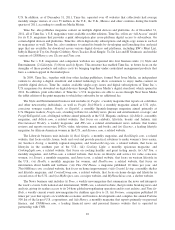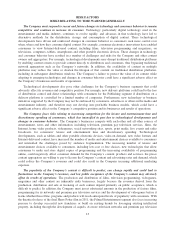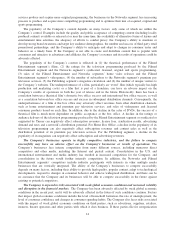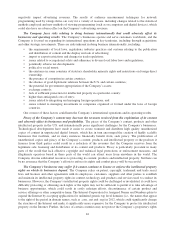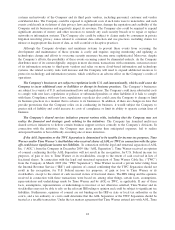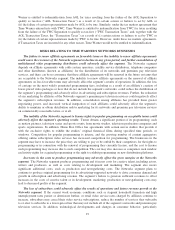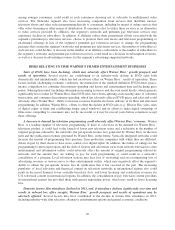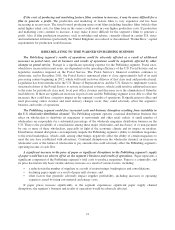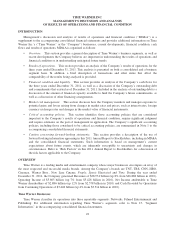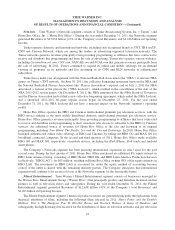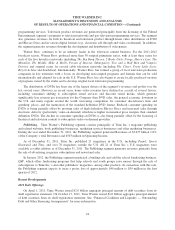Time Magazine 2011 Annual Report Download - page 28
Download and view the complete annual report
Please find page 28 of the 2011 Time Magazine annual report below. You can navigate through the pages in the report by either clicking on the pages listed below, or by using the keyword search tool below to find specific information within the annual report.services produce and acquire more original programming, the businesses in the Networks segment face increasing
pressure to produce and acquire more compelling programming and to optimize their mix of acquired, original and
sports programming.
The popularity of the Company’s content depends on many factors, only some of which are within the
Company’s control. Examples include the quality and public acceptance of competing content (including locally
produced content) available or released at or near the same time, the availability of alternative forms of leisure and
entertainment time activities, the adequacy of efforts to combat piracy, the Company’s ability to maintain or
develop strong brand awareness and target key audience demographics, the number and success of third-party retail
promotional partnerships, and the Company’s ability to anticipate and adapt to changes in consumer tastes and
behavior on a timely basis. If the Company is not able to create and distribute content that is popular with
consumers and attractive to advertisers and affiliates, the Company’s revenues and its results of operations could be
adversely affected.
The popularity of the Company’s content is reflected in (1) the theatrical performance of the Filmed
Entertainment segment’s films, (2) the ratings for the television programming produced by the Filmed
Entertainment segment and the Networks segment’s syndicated, licensed, original and sports programming,
(3) sales of the Filmed Entertainment and Networks segments’ home video releases and the Filmed
Entertainment segment’s videogames, (4) the number of subscribers to the Networks segment’s premium pay
television services, (5) the Publishing segment’s magazine circulation and (6) the number of unique visitors to
the Company’s websites. The underperformance of a film, particularly an “event” film (which typically has high
production and marketing costs) or a film that is part of a franchise, can have an adverse impact on the
Company’s results of operations in both the year of release and in the future. Historically, there has been a
correlation between a theatrical film’s domestic box office success and international box office success, as well
as a correlation between box office success and success in subsequent distribution channels. Consequently, the
underperformance of a film at the box office may adversely affect revenues from other distribution channels,
such as home entertainment and premium pay television services, and sales of videogames and licensed
consumer products based on such film. In addition, due to the decline in the sales of DVDs, the success of a
theatrical film is much more dependent on public acceptance at the box office. A decline in the ratings or
audience delivery of the television programming produced by the Filmed Entertainment segment or syndicated or
originated by Turner can negatively affect subscription revenues, license fees, syndication results, advertising
demand and rates and a network’s distribution potential. For Home Box Office, a decline in the popularity of its
television programming can also negatively affect subscription revenues and content sales as well as the
distribution potential of its premium pay television services. For the Publishing segment, a decline in the
popularity of its magazines can negatively affect subscription and advertising revenues.
The Company’s businesses operate in highly competitive industries, and the failure to compete
successfully may have an adverse effect on the Company’s businesses or results of operations. The
Company’s businesses face intense competition from many different sources, including numerous direct
competitors and other media, including the Internet and pirated content. Consolidation in the U.S. and
international entertainment and media industry has resulted in increased competition for the Company, and
consolidation in the future would further intensify competition. In addition, the Networks and Filmed
Entertainment segments’ competitors include industry participants with interests in other multiple media
businesses that are vertically integrated. The ability of the Company’s businesses to compete successfully
depends on many factors, including their ability to provide high-quality, popular content, adapt to technological
developments, respond to changes in consumer behavior and achieve widespread distribution, and there can be
no assurance that the Company and its businesses will be able to compete successfully in the future against
existing or potential competitors.
The Company is exposed to risks associated with weak global economic conditions and increased volatility
and disruption in the financial markets. The Company has been adversely affected by weak global economic
conditions in the recent past, and it will be adversely affected in the future if such conditions continue. Factors
that impact global economic conditions include the level of household formation, the rate of unemployment, the
level of consumer confidence and changes in consumer spending habits. The Company also faces risks associated
with the impact of weak global economic conditions on third parties, such as advertisers, suppliers, retailers,
insurers, theater operators and other parties with which it does business. If these parties file for reorganization
14




